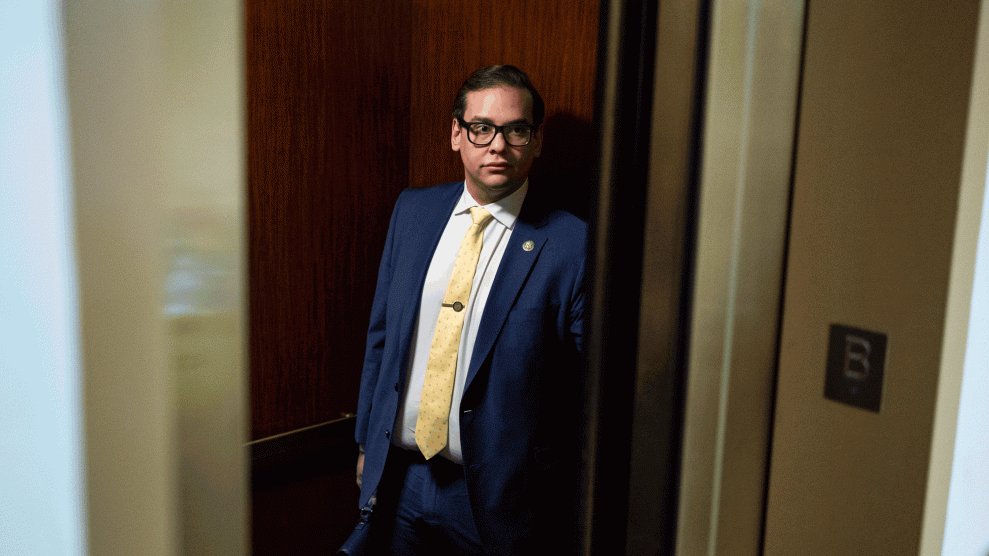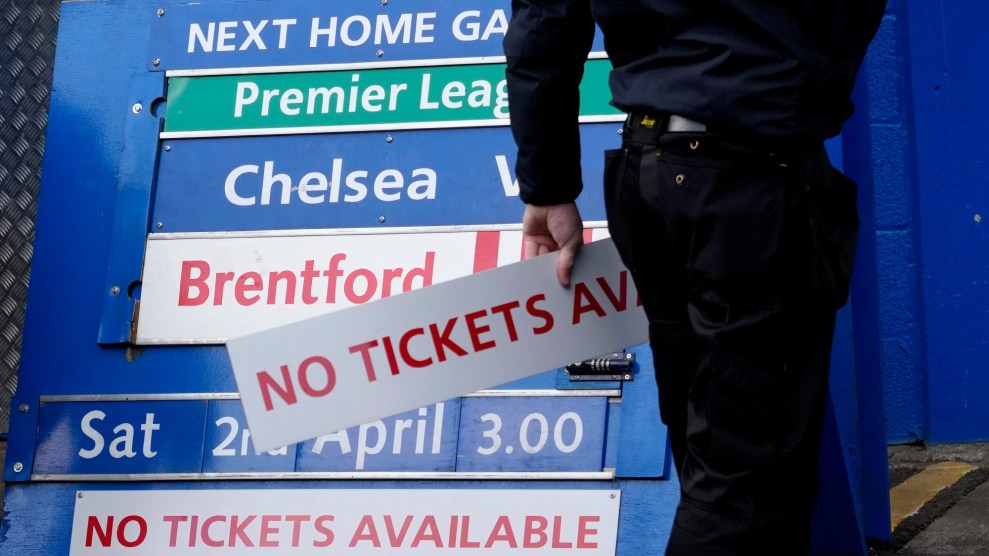When the US targeted Russia’s oligarchs after the invasion of Ukraine, the trail of assets kept leading to our own backyard. Not only had our nation become a haven for shady foreign money, but we were also incubating a familiar class of yacht-owning, industry-dominating, resource-extracting billionaires. In the January + February 2024 issue of our magazine, we investigate the rise of American Oligarchy—and what it means for the rest of us. You can read all the pieces here.
Any super-rich schmuck can buy a yacht. Or a mansion. Even Elmer J. Fudd, millionaire, owned a mansion and a yacht. Multi-millionaires and billionaires can buy many things that (loudly) telegraph their wealth, from Lamborghinis to Birkins to Rolexes. But instead of asserting the prosperity, taste, and exclusivity the titans of the world assume, these possessions signal that this super-rich person is, in fact, an unsophisticated super-rich schmuck.
But, if a wealthy person aspires to be more than just another Kardashian, one asset transcends all of this and changes the very identity of its owner, notably in the eyes of society. That luxuriously special, quintessentially refined asset is art. I’m not talking about art from a local gallery or poster shop or Etsy or eBay. I’m referring to the most expensive art in the world; by Rembrandt, Van Gogh, Picasso, Monet, Warhol, Pollock, Koons. These are the preferred investment vehicles for really smart and/or really insecure oligarchs.
The planet’s power brokers know that society will accept the recently wealthy—but only up to a point. When a person wants to take the next step up the food chain, when they want to stick out beyond the others in high society, they buy art. Rich people who become art collectors are no longer viewed by society as simply rich, or (God forbid!) nouveau riche. When a mogul collects art, a whole new set of adjectives is used to describe them: refined, cultured, urbane. Indeed, they have graduated. Art is the way the rich buy legitimacy.
And oligarchs, who are further tainted by the whiff of corruption and undue privilege, need to legitimize themselves more than anyone else. Their art collections soften their image. Surely a person who appreciates beautiful things can’t be that bad. Like Al Capone in The Untouchables, who cries at the opera, an appreciation for art humanizes even the most vicious real-life Bond villains.
Before we continue, let me dispense with a formality. I happen to know all this because, as a high-end art dealer, I’ve personally interacted with oligarchs from all over the world. I’ve sold them Lichtensteins, Rothkos, Matisses, Dalis, and others at the highest level. Art is a business of discretion and secrecy, qualities that oligarchs prize. But, unlike all my colleagues in the art business, I’ve decided to tell it like it is. Why? I suppose you might say that I am in a unique position. I got busted for wire fraud some years ago and was imprisoned for more than a year in Otisville, a minimum-security camp in upstate New York.
To save my gallery from financial ruin, I had desperately resorted to lying about payments and taking loans on things that weren’t ours. That is until my partner got spooked and turned me in. I admit that I feel guilty about it all; I didn’t want to fuck anyone over—but inadvertently, I did.
I also feel a bit salty for having become the poster boy for corruption in the art business, when most of the industry is about hiding money, misrepresentation, and general malfeasance. But now, the world is a beneficiary of my fuckup, as I’ve decided to share my arcane knowledge so that less-rich people can learn about the shit that goes down with the ruling elite. And shit does go down—all over the world.
We think of oligarchy as a foreign concept, but the truth is that American oligarchs abound, and many of them collect art. It’s a time-honored strategy. The robber barons of old took time between amassing their wealth and industrializing our cities to build world-class museums—the Frick, the Carnegie, MoMA. We can only hope that the new oligarch collectors follow suit.
Should you happen to speak to former Secretary of Commerce Wilbur Ross, ask him if he’ll donate his Magritte collection to a museum. Ronald Lauder, a huge Republican donor and confidante of politicians, has a phenomenal collection of Austrian Secessionist art, some of which he displays in his own first-rate museum. The late Ambassador Donald Blinken (Antony’s father) owned four wonderful Rothkos. Even Donald Trump claims to own a Renoir, though an identical one hangs at the Art Institute of Chicago, making one of the two a fake (guess which?). One day there may be a Donald Trump museum; his “Renoir” can hang there.
I had high-end galleries in New York and in Moscow for years, and so I got to understand oligarchs pretty well. Over plenty of champagne, or vodka, they explained why they loved buying art.
“Did you see the ARTnews list of top collectors?” one ultra-wealthy American hedge fund manager asked me many years ago. He had been collecting for about a year, just starting to explore the Impressionists and early moderns—an easy entry point for newbies. But this guy was so rich that he’d bought some very expensive entry-level paintings.
“Are you in the top 200?” I was at once surprised and happy for him.
“I’m in the top 10!” he said, equally dumbfounded.
Simply by buying some expensive art, this really rich guy immediately was transformed. He was no longer one of many in a growing list of lucky, brash, crass billionaires, but a man of culture, sophistication, and taste. Never mind that, as he confessed to me, “I don’t know the difference between Monet and Manet.” He had completed his metamorphosis and emerged a beautiful (social) butterfly.
This instant identity upgrade is a dream scenario and the top reason, psychologically and sociologically, why oligarchs collect art.
The problem is that public adulation of a wealthy new collector attracts a swarm of art insects (dealers, advisors, curators) who are so relentlessly obsequious that the newly minted collector eventually begins to believe the buzz.
“I want to be a tastemaker,” my rich friend told me soon after his ARTnews star turn, indifferent to the fact that any member of the cognoscenti should at least be able to differentiate between two of the most famous Impressionist masters. But you can hardly blame him. After having been enthusiastically fêted and honored, he had to believe that his talents extended beyond the stock ticker and onto the walls of the world’s top museums—where his paintings would occasionally be displayed on loan with the quiet acknowledgment of ownership.
“I want art that fits in my suitcase,” a wealthy Russian collector I’ll call Yevgeny (no real names—I don’t wish to fall out of any windows) told me. “That way, if something crazy happens, I can take my art and get the fuck out of here.”
This sentiment is not unique. One of the draws of art is that it is easily transportable and thus easy to smuggle. Yevgeny could put his small Kandinsky, which is worth $10 million, in a hardshell rollaway bag, and take it on his plane to Malta or Macau or even New York or London. Nobody would know that he just moved all that money across borders. By doing this, Yevgeny would take full advantage of the esoteric nature of the asset and the lack of international regulation.
If you’ve ever traveled internationally on a private plane (sorry, art dealers can be snobs), you would likely notice the lax enforcement of rules most fliers take for granted. As we mere mortals battle the lines and red tape at airports, for those traveling in the private air corridors, inconveniences like passport control or customs officials are batted away like insignificant bugs. Nobody declares much, and less than nobody checks the cargo onboard.
Authorities’ ignorance about art is another secret weakness in the chain. I often have traveled with art, and I’ve never once had anyone realize that what I was bringing in was, say, a Miró, and not something my young nephew made. This lack of expertise extends to valuations. How could a customs agent know that the work I’m transporting is worth $10 million, and not the $10,000 I may declare? Indeed, the legal import and export channels can become quite porous for art. If you’re wondering whether I’ve ever taken advantage of these weak links to smuggle art, corner me in a bar somewhere and inquire discreetly.
But it is the supreme globalism of the art trade that makes regulation impossible. These are borderless transactions, wherein a deal might close in New York, the funds are transferred in the Bahamas, and the painting is delivered in a Swiss or Singaporean free port. Which jurisdiction would be in charge of such a deal? Nations have little incentive to step in, because strengthening regulation in the US, for example, would just move the trade elsewhere.
Put simply, there is no better vehicle than art with which to hide and transport funds. It is no secret that famed Russian collector Dmitry Rybolovlev amassed his collection of priceless masterworks quietly. The art world buzz was that he aimed to stash the bulk of his wealth into something his soon-to-be ex-wife could not easily track—a buzz confirmed by the Panama Papers. Unfortunately for Rybolovlev, suing his adviser (long story) in a very public fashion, buying a supposed Leonardo (longer story). and now initiating a giant lawsuit against the storied auction house Sotheby’s has brought him enough notoriety to scuttle his original plan
Note to oligarch collectors: If you’re trying to avoid attention, don’t buy Salvator Mundi, the most expensive painting ever sold. I’m talking to you, MBS. (Saudi Arabia’s Mohammed Bin Salman is its current owner.)
But this is just a very public example of art being used sneakily. Privately, I’ve seen collectors hide assets from their siblings, parents, wives, mistresses, children, the government, and the public. Mostly these shenanigans remain secret, but plenty have come to light: Imelda Marcus, the Philippines’ former First Lady and current First Mother, and convicted Malaysian financier Jho Low each used their respective countries’ public funds to adorn their homes with Monets. Bernie Madoff’s lieutenant, Ezra Merkin, famously sunk his ill-gotten wealth into a collection of Rothkos. Anita Halpin, chair of the Communist Party of Britain, became fabulously rich when she quietly began to sell off her inherited collection of Nazi-looted-then-restituted pictures. And she would’ve gotten away with it if it weren’t for those meddling journalists.
We know oligarchs exist in every country. The ones in the US are often referred to as “philanthropists,” but they also enjoy their access to the levers of power. At this point, most major Russian oligarch collectors, including some of my former clients, have been sanctioned and thus stopped collecting. One client even was indicted and has since fled back to Russia. Let me pause to send him a private message: I understand what you’re going through, comrade, but I recommend you come back and face the music. Club Fed wasn’t that bad.
But the art world is resilient, and when one set of oligarch buyers dries up, we move on to the next. I’ve lived through periods of mania over billionaire buyers from Japan to the Middle East to Wall Street to Russia to China—and back to the Middle East. There will always be billionaires somewhere searching for something to do with their cash. Whether your name is Abramovich or Lauder, Koch or Zhukova, as long as you have money and influence, I humbly recommend, as any good dealer would, you consider art as a (mostly) legal means to protect your wealth and get you invited to lots of parties—communist or otherwise.













